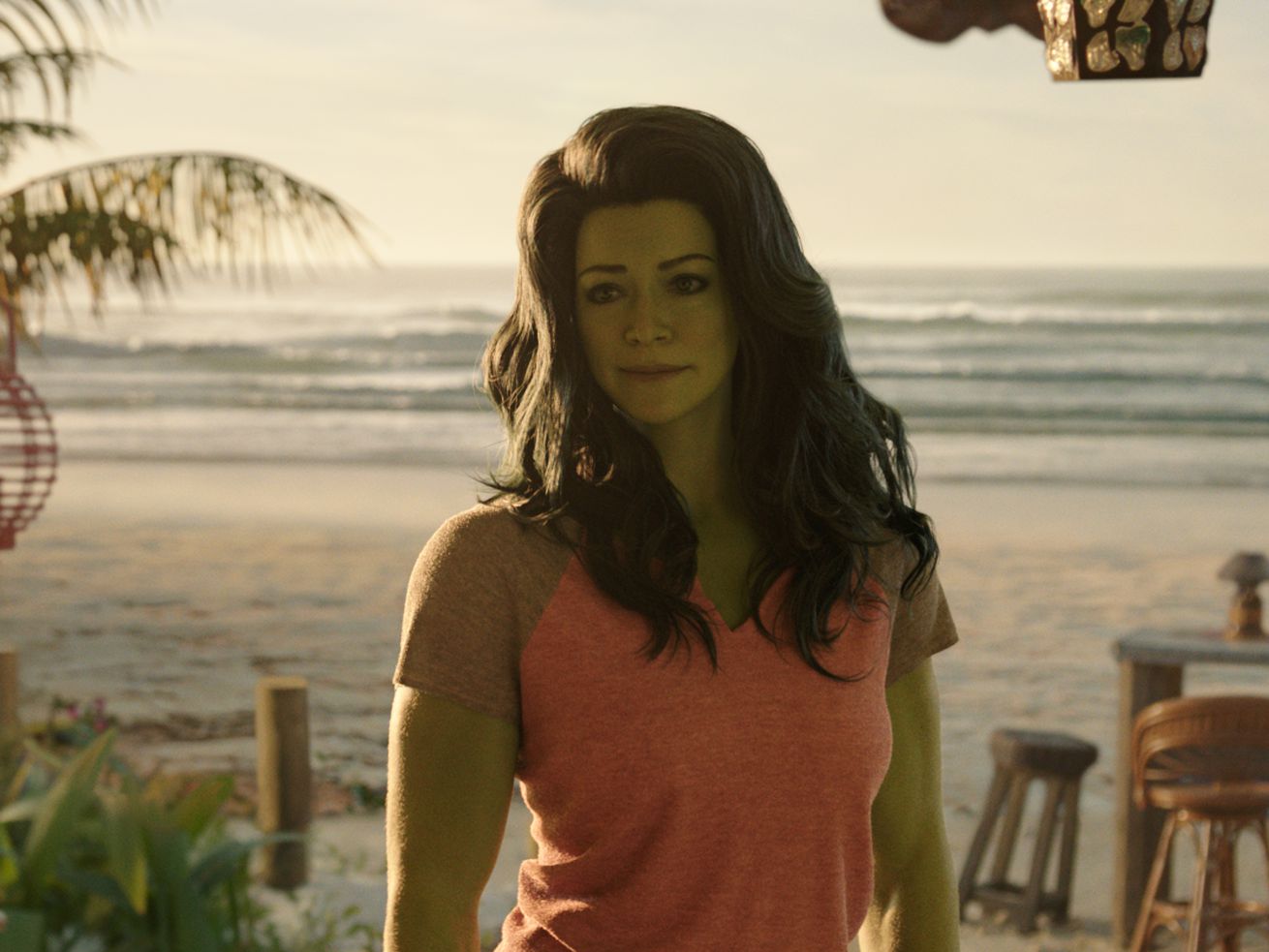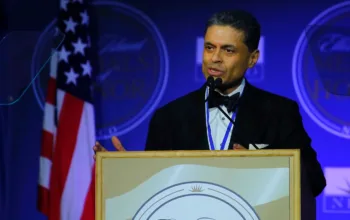The MCU’s version of a legal procedural can be fun as hell.
Beneath She-Hulk’s quippy gags, trippy world-building, and zippy cameos is a heartfelt question: What if you dared to be big?
For Jennifer Walters (Tatiana Maslany), that query comes quite literally as she’s gifted with the powers of a Hulk. To be a Hulk — like her cousin, Bruce Banner (Mark Ruffalo) and his alter ego — means having super strength, near invulnerability, and heightened athletic prowess, among other powers. But those gifts come with a price. Over several Marvel movies, starting with Avengers: Age of Ultron in 2015, we’ve seen Bruce struggle with lack of control, loneliness, and his fear of hurting others. That’s all not to mention the duty, and burden, of using his abilities to protect and save the defenseless.
Jennifer also struggles with the existential questions around what it means to be big, but they affect her differently than they do her cousin, for one obvious reason.
Fictional MCU Earth is unfortunately a lot like the real world. Women are asked to shrink themselves to accommodate those around them. Jen has had a life of being told to stay out of the way, to be anyone but herself.
Within those boundaries, she’s carved out a good-enough life. She’s content. She’s comfortable. Becoming the She-Hulk threatens all of this, and not just because she becomes a lime-skinned anger monster. Her superpowers also spark in her a sense of defiance; they allow Jen to circumvent the rules set for her. Her powers offer Jen a tantalizing prospect: that she could create a life better than the one society has dealt. That is its own kind of scary, especially for someone who has learned to live a tiny life.
As she finds out, it’s not easy to choose to be big. It may even require being brave.
She-Hulk isn’t about girlbossing, gaslighting, and gatekeeping superheroism
I suppose you could call She-Hulk: Attorney at Law a “legal procedural” the same way you could call Captain America: Winter Soldier a “political thriller.” It involves a lot of generosity.
In the first four episodes critics were given, there are plots in which Jen has to figure out the legal ramifications of supervillain parole or how to serve a cease and desist to unlicensed magic users. These cases raise some perplexing philosophical questions. Like, what does the MCU want to say about prison reform and rehabilitation? Or how does the law — in which power is mostly abstract — hold actual magic users responsible? It’s a funny conceit, but the legal cases give texture to the MCU and offer a glimpse into the effects that superheroes have on civilian life.
Unfortunately, the show never really goes that deep into how cases are won or, so far, how one might navigate the complicated intersection between nuanced lawyerly duties and more straightforward superhero ones. The good guys are good. The bad guys are bad. The bad guys who are reformed are good now. Most of the time, Jen’s side is the just one.
/cdn.vox-cdn.com/uploads/chorus_asset/file/23949505/CLO_101_11223_R.jpg)
Chuck Zlotnick
She-Hulk: Attorney at Law largely works, though, because it’s not actually a legal procedural — it’s more of a comedic origin story. It all hinges on Maslany’s breezy and charismatic portrayal of Jen. She grounds the character with mountains of approachable appeal, like someone you wouldn’t mind eating a bagel in front of. Her performance cuts through that much-criticized CGI.
At the start, Jen is content in her circumscribed life. She’s a single lawyer with a loving but annoying family. Her paralegal (Ginger Gonzaga) is her best friend. She’s proud of her work in the DA’s office. Jen isn’t living large, but things could be much worse.
The character’s big goals in life are to date more and have a great job. She’s relatable and practical. She probably has a five-year plan. If someone threw out the idea of the endless, ever-expanding multiverse, Jen would say that she wants to live in the timeline where she didn’t amass student loans in law school. If given the choice to live a superhero’s life, she would ask if it offered health care (the Avengers famously do not).
But she isn’t given a choice. Thanks to a freak accident in which she absorbs some of her cousin’s gamma-radiated blood, Jen gains super strength, invulnerability, and broccoli-hued skin. Unlike Bruce, though, she’s able to control it. As she explains, life as a woman already means controlling anger and emotion; she’s well practiced at not seeming too mean, too rageful, too much. Switching between her Hulk form and regular civilian form is easy. That it’s so difficult for Bruce shows reflexively how men aren’t held to the same standards.
Superpowers as a symbol for female liberation — and how that empowerment threatens the status quo — isn’t new. It’s as old as the goddesses depicted in ancient legends or the accusations of witchcraft across centuries. Plus, the allegory is right there in so many Marvel and DC comic books. The show picks up this tradition and builds on it. An ongoing plot line revolves around She-Hulk’s impenetrable — that is, thick — skin!
Till now, Marvel’s cinematic track record with its female superheroes has been, well, a mixed bag. It took more than a decade and 20 movies before the studio created its first female superhero movie in 2019’s Captain Marvel. In 2021, Natasha Romanoff a.k.a. Black Widow (Scarlet Johansson) received her first movie (a prequel), and that same year Wanda Maximoff a.k.a. Scarlet Witch (Elizabeth Olsen) got her own series in WandaVision. Both were ultimately killed off — Wanda in Multiverse of Madness and Natasha in Endgame. The pattern of elevating a woman superhero to a high profile then having her die by self-sacrifice isn’t exactly great optics.
Marvel’s television offerings like Hawkeye and Ms. Marvel are more promising. They have not only allowed its titular female heroes to live but actually laid solid foundations for their futures. She-Hulk joins Hawkeye’s Kate Bishop (Hailee Steinfeld) and Ms. Marvel’s Kamala Khan (Iman Vellani) as the second generation of Marvel’s female superheroes.
But Marvel is still getting its sea legs when it comes to onscreen feminism. There are more than a few instances in which, say, Jen has a line about mansplaining or a character jokes about cat-calling. These moments seem to exist solely because the writers see them as easy signals to the audience — flashing neon signs that point out this behavior as sexist. I’m left wondering who that’s for. Perhaps I’m naive, but I’d hope that someone tuning into She-Hulk and wanting to enjoy it would know that cat-calling a woman on the street is not good behavior.
I guess I’m also deeply cynical in that I do not think a joke on She-Hulk: Attorney at Law is the thing that will keep someone from participating in blazing misogyny. We’ll see how far Marvel wants to go in examining the sexist world She-Hulk pushes back against.
In She-Hulk, super powers help its hero find out who she is
What the show does particularly well is handle Jen’s identity crisis with her newfound abilities. This struggle lands more successfully than the more obvious nods to gender inequality; it includes canny observations about how women move within the world.
Being big and strong allows Jen to access a world that she’s never been allowed to be a part of. Regular people don’t get to beat up demons, throttle muggers, or save lives, but as She-Hulk, Jen can do all of those things. She wields literal physical power, and experiences joy in doing so. Even some of the things that bug her in civilian life — dating, jerks at work, family life — can be alleviated by punching some henchman.
Her Hulk form also seems to bring her closer to who she really is, and that’s something to be excited about.
Transforming into the Hulk lets Jen tap into the primal glee of not only being strong, but also being aggressive, loud, flashy, proud, cocky — things she hasn’t allowed herself to be before. These qualities allow her to thrive at her new job as a superhero law attorney, get multiple matches on dating apps, and become famous. As She-Hulk, she has an extremely hot one-night stand! Good for She-Hulk for being the first MCU superhero to use her powers for horniness.
/cdn.vox-cdn.com/uploads/chorus_asset/file/23949510/HTH1320_101_comp_v164.1063_C.jpg)
Marvel Studios
Indulging in it feels natural to Jen, so natural that she begins to question if She-Hulk is actually who she was always meant to be. If society hadn’t taught her to shrink, would this be her life? At the same time, what if she likes the parts of her that aren’t She-Hulk?
Jen wrestling with her sense of self and sorting which parts are the “real” her isn’t tidy.
Being a Hulk doesn’t affect her intelligence or her work ethic, yet it has enabled her to get a better job (and better health care). But her new success brings to light the way Jen has been continually overlooked and taught to undercut herself. Her new powers have made clear how unfairly she’s been treated, and now she has the ability to do something about it.
So why would she want to go back to her old life? And wouldn’t a hero, if they were really a good-to-the-bone hero, want to change the way that world works?
It seems clear the show wants us to understand that power isn’t just great responsibility, it’s also great privilege. There’s a distinction there. One is about recognizing what you owe other people; the other is about recognizing what we owe ourselves. And the joy of She-Hulk is that Jen, I think, sees both.
She-Hulk: Attorney At Law premieres on August 18 on Disney+.
Author: Alex Abad-Santos
Read More



